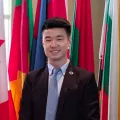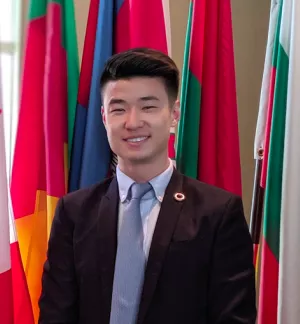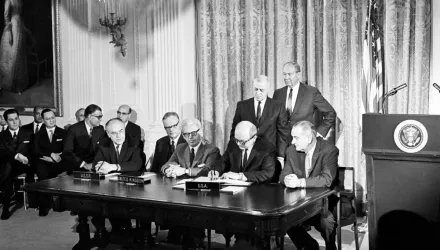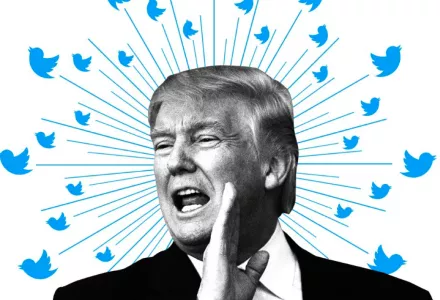
Just two weeks ago, a tweet cost the global stock markets roughly $1.36 trillion (or Australia’s annual GDP). With 280 characters on Twitter, the U.S. President Donald Trump threatened to raise tariffs on select Chinese imports, instilling lower market confidence, triggering significant volatility, and exacerbating existing political uncertainties. Using Twitter as a form of diplomacy, President Trump signalled U.S.-China’s deteriorating trade relations to the entire world.
Twitter diplomacy is when world leaders and government agencies issue foreign policy-related statements and reactions over Twitter. No longer merely a place for celebrity feuds and snarky commentary, Twitter has become the preferred social media platform for public officials and governments to communicate their foreign policy positions. To explore what is really at stake in Twitter diplomacy, it is important to explore why Twitter diplomacy matters, why world leaders use it, what it means for diplomatic relations, and how governments can manage the associated risks.
Why Does Twitter Diplomacy Matter?
In 2007, Barack Obama — then Senator of Illinois — became the first global leader to join Twitter. By 2013, roughly 78 percent of the 193 United Nations member states had some form of official presence on Twitter, and by 2018, that number increased to 97 percent. Today, out of all the world’s current leaders, U.S. President Donald Trump is the most popular on Twitter with roughly 60 million followers. Since winning the 2016 presidential elections, President Trump saw his Twitter followers surge by 230% within a year1 (compared to a 13% growth in 20152 before he formally announced his presidential candidacy).
In comparing the world’s 25 most followed current world leaders, President Trump is incontestably the most influential because his tweets are impressively amplified by retweets, receiving on average 20,000 retweets per tweet. Yet, unlike Saudi Arabia’s King Salman bin Abdulaziz Al Saud or the Pope — who are also highly influential on Twitter — President Trump tweets on average seven times as much as they do. This suggests that while President Trump is indeed an influencer, he also spends a lot more of his working time on Twitter. With most global leaders active in the Twittersphere today, their messages have also started to include foreign policy-related topics.
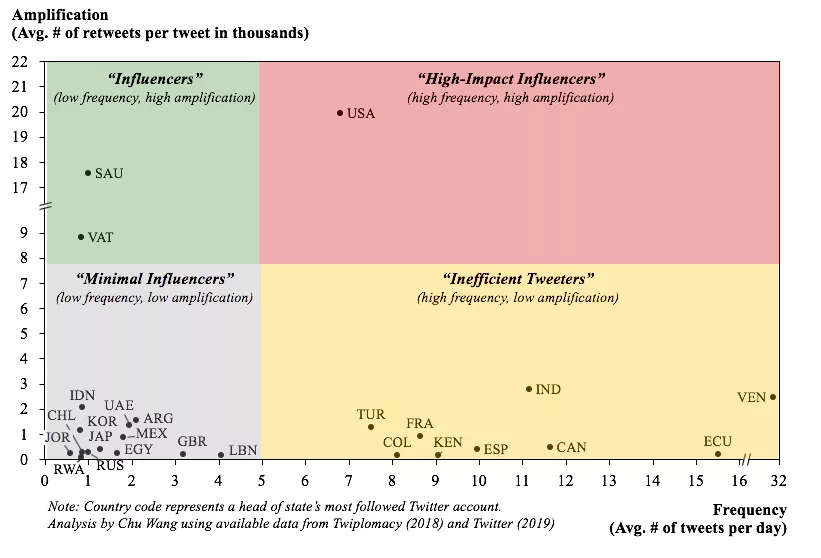
Twitter diplomacy is ubiquitous in global affairs. Even long before President Trump started tweeting out foreign policy stances, other world leaders had already caused controversy: In 2012, Estonian President Toomas Hendrik blasted a New York Times blogger on Twitter for criticizing Estonia’s economic recovery and since 2011, Rwanda President Paul Kagame has been involved in heated Twitter exchanges with the foreign media. As world leaders increase their digital diplomacy on one of the world’s largest social media platforms, it then begs the question: why do they use Twitter as a diplomatic tool?
Why Do World Leaders Use Twitter Diplomacy?
Compared to traditional modes of diplomacy, such as private calls and backchannels, Twitter diplomacy offers three distinct advantages: increased accessibility, message control, and accelerated network effects.
1. Increased accessibility: Twitter offers leaders direct access to the public and a larger audience base. Unlike traditional media tools for diplomacy (e.g., communiqué, press conference, etc.) that rely on editing, filtering, and managing multiple stakeholders, Twitter allows leaders to share an unfiltered message with the public at any time. Leaders can bypass complex bureaucratic processes and iterations required by government agencies — mechanisms that can slow down the flow of information. Leaders can also instantaneously access millions of users (although the politically-engaged audience on Twitter is not always representative of the true demographic) and tap into a larger, more diverse, and more global audience — one that traditional diplomacy or media outlets are often unable to achieve.
2. Message control: With greater access to more users, world leaders can control the meaning, tone, and integrity (or sometimes lack thereof) of their messages. Bypassing iterations with different government agencies means that there are fewer filters to limit the leader’s intended meaning and ambiguity towards what he or she is actually trying actually to convey. By controlling the message, the leader can shape the domestic narrative and how the local audience perceives the foreign policy issue. This is especially useful if leaders want to rally domestic support for their own foreign policy agenda.
3. Accelerated network effects: Twitter allows world leaders to shorten feedback loops and leverage their networks to amplify messages. A shortened feedback loop means that, within minutes, leaders can gauge the public’s and other foreign leaders’ reactions to a tweet. In short, Twitter cuts out the middle person who provides that feedback. A greater ability to leverage their networks means that leaders can more quickly develop diplomatic or public acknowledgement through likes and retweets. For instance, if another leader likes or retweets, then the original message is amplified further in other peoples’ Twittersphere.
While these advantages have enticed global leaders to adopt Twitter diplomacy, there are also associated risks — especially ones that can impact diplomatic relations.
What does this mean for diplomatic relations?
Aside from the U.S.-China example, there have been many other Twitter diplomacy cases that constrained and exacerbated bilateral relations. In the current information era, Twitter diplomacy has several implications for diplomatic relations.
1. Relationships are more fragile and “undiplomatic.” Despite its network effects, Twitter diplomacy has also increased the risk of diplomatic tensions and conflicts. For example, in August 2018, Canadian Foreign Minister Chrystia Freeland criticized the Saudi government for arresting activists and called for their release on Twitter. The next day, the Saudi government retaliated by expelling Canada’s ambassador to Saudi Arabia, ceasing flights to Canada and suspending student exchange programs. What started as a frustrated tweet created a deep fissure in Canadian-Saudi relations. With the ability to post uncensored tweets, world leaders and agencies can often bypass traditional, bureaucratic procedures, which are meant to promote rational decision-making (vis-à-vis mandatory risk assessments or other control mechanisms). Even a slight misinterpretation or uncertainty from the other side can escalate tensions. Thus, there sometimes may be a trade-off between rapid information flow and poor, less rigorously-vetted, and irrational decisions that damage diplomatic relations.
2. Tweets can directly prescribe formal positions and foreign policies. With the ability to control messages, leaders can declare their unfiltered position to the public without consulting or ignoring expert advice. For example, in December 2018, despite U.S. Defense Secretary Jim Mattis’ advice to keep U.S. troops in Syria, President Trump tweeted a video announcing the withdrawal of 2,000 U.S. troops from Syria. This became the United States’ formal position and triggered government officials to frantically clarify the withdrawal details. In addition to circumventing traditional foreign policy-making procedures, Twitter diplomacy permits leaders to declare top-down foreign policy decisions, forcing other government agencies to adopt them. For domestic agencies and foreign officials, this also means that they have to actively monitor public leaders’ Twitter accounts to understand evolving policy positions.
3. Leaders risk exposing their personal opinions, preferences, and emotions. While being able to control the message, leaders sometimes allow their personality and emotions to drive decision-making. Unlike a private phone call, tweets offer adversaries a window into a leader’s personal views. For example, after winning the 2014 Indian elections, Indian Prime Minister Modi responded to congratulatory phone calls by thanking country leaders over Twitter — starting with Canada and making the U.S. wait for nearly two days. His public rank-order signalled to the world his favoritism and prioritization of foreign relationships. Contrary to keeping adversaries in the dark, Twitter diplomacy helps allies and adversaries to better understand and analyze a leader’s psyche and foreign policy approach. This also means that adversaries can more easily identify vulnerabilities in diplomatic relations, exploit fractures in alliances, and even seek ways to provoke the leader (e.g., fuel the leader’s resentment or discontent).
Where do we go from here?
To mitigate the risks associated with Twitter diplomacy, public officials and government media teams should explore several procedural, training, and technological strategies. Mitigating these risks does not mean forgoing a leader’s right to free speech. The overall objective of these strategies is to manage inappropriate and/or premature tweets. However, they are not exhaustive, and some are more effective for certain audiences.
1. Update the government’s social media guidelines, procedures, and protocols. Many agencies and associations, such as the U.S. State Department, already have social media guidelines. However, these guidelines should be updated with additional procedures and protocols that encourage rational decision-making. They should also be applied to all foreign-facing representatives of a country, including the head of state. Whether it is for a country that should update existing guidelines or a country that is currently designing them, there are several ways to manage risks vis-à-vis internal guidelines:
- Adopt a two- or multi-step review process: Adding this in the social media procedures can ensure that a leader’s tweet is vetted before posting. While the review process should be agile and targeted at mitigating potential calamities, it should not violate the leader’s right to free speech. An agile process can help manage the risk of irrational tweets while ensuring timely decision-making and public announcements.
- Add in consultation requirements: For some issues, it may be useful to build consultation requirements on social media posts into an agency’s public relations procedures. For national security-related issues, the head of state or foreign minister should be encouraged to consult national security experts before posting. Not doing so, may result in consequences (see below).
- Detail consequences: Governments should specify in their protocols the consequences of violating social media guidelines (e.g., temporary account suspension). While having consequences may be less effective to deter leaders like President Trump from posting inflammatory or high-risk content, governments should still detail consequences to better manage lower-ranking officials. Having consequences can create a more respectful social media culture among new and emerging public leaders. In deciding on the appropriate consequences, governments should tailor them to fit within their own country’s norms and laws.
2. Mandatory social media training for government leaders. Instead of criticizing leaders for their inappropriate tweets, government agencies should ensure that leaders are aware of the associated risks and consequences. Especially in the information era, newly elected or appointed public officials should undergo mandatory social media training. This includes educating them on past incidents and the consequences due to poor Twitter diplomacy. As well, digital-listening training can teach them to better collect, process, and analyze political discussions on different social media platforms. As an example, government agencies like the U.S. State Department’s Office of eDiplomacy or non-partisan organizations like the Harvard Kennedy School’s Institute of Politics can offer such training. Culture change is often slow and such training may not be applicable to select leaders like President Trump. However, social media training should be targeted towards new and emerging leaders who can transform the culture of digital diplomacy in the mid- to long-term.
3. Build in social media functionalities. Twitter and other social media platforms currently offer different functionalities that encourage more review and reflection time. These functionalities can make a big difference in the quality of tweets:
- Include a posting delay: Scheduling tweets or building a few minutes delay before publishing a tweet (using platforms like TweetDeck) can allow for more reflection time. This additional time can allow leaders to rethink the post and edit it after longer consideration.
- Build an automatic flag: Automatically flagging inappropriate or high-risk words to the leader before posting can help manage a tweet’s content and tone. For example, if the word “war” is in the tweet, flagging this before the tweeter is allowed to post can prompt him or her to reflect more critically, reconsider, and update the words.
In the current digital age, Twitter has enabled world leaders to reach a broader audience while fully controlling their message and benefiting from accelerated network effects. Yet, the examples from Canada, Saudi Arabia, the United States, and India are only a subset of Twitter diplomacy cases gone awry. Twitter diplomacy has very real implications to diplomatic relations, and it is critical that governments manage the associated risks. To start, governments need to rethink their social media guidelines, training programs, and technological tools. If the risks of Twitter diplomacy are not properly managed, then one day, a Twitter war may end up triggering a real war.
Acknowledgements: I would like to thank Cathryn Clüver Ashbrook, Executive Director of the Future of Diplomacy Project, for her mentorship in writing this piece.
Footnotes:
1. From November 8th, 2015 to November 8th, 2016
2. From June 16th, 2014 to June 16th, 2015

About Chu Wang
Chu is a Master in Public Policy student at the Harvard Kennedy School (HKS) and interning at the United Nations’ Executive Office of the Secretary-General (EOSG) this summer. Born in Beijing and raised in Ottawa, Chu is passionate about driving social progress through economic development globally. At HKS, Chu is a Research Assistant for the Belfer Center’s Future of Diplomacy Project (FDP). In addition to researching statecraft and diplomacy, Chu has also designed seminars and itineraries for senior officials, including Secretary-General Ban Ki-moon and High Representative Federica Mogherini. Prior to Harvard, Chu worked as a management consultant for Boston Consulting Group (BCG) where he developed economic strategies for Canadian cities and female empowerment policies for a Middle Eastern government.
Wang, Chu. “Twitter Diplomacy: Preventing Twitter Wars from Escalating into Real Wars .” May 20, 2019

